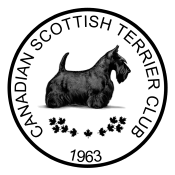General Appearance
The face should wear a keen, sharp, and active expression. Both head
and tail should be carried well up. The dog should look very compact,
well muscled and powerful, giving the impression of immense power in
a small size.
Size
Equal consideration must be given to height, length of back and
weight. Height at shoulder for either sex should be about 10 inches
(25 cm). Generally, a well-balanced Scottish Terrier Dog of correct size
should weigh from 19-22 lb. (9-10 kg), and a Bitch, from 18-21 lb. (
8-9.5 kg). The principal objective must be symmetry and balance.
Coat and Colour
Coat rather short, about 2 inches (5 cm), dense undercoat with outer
coat intensely hard and wiry. Colour steel or iron grey, brindled or
grizzled, black, sandy or wheaten. White markings are objectionable
and can be allowed only on the chest and that to a slight extent only.
Head
Skull long, of medium width, slightly domed and covered with short,
hard hair. It should not be quite flat, as there should be a slight stop
or drop between the eyes. Muzzle in proportion to the length of skull,
with not too much taper towards the nose. Nose should be black and
of good size. The jaws should be level and square. The nose projects
somewhat over the mouth, giving the impression that the upper jaw
is longer than the lower. The teeth should be evenly placed, having a
scissors or level bite, with the former being preferable. Eyes set wide
apart, small and of almond shape, not round. Colour to be dark brown
or nearly black. To be bright, piercing, and set well under the brow.
Ears small, prick, set well up on the skull, rather pointed but not cut.
The hair on them should be short and velvety.
Neck
Moderately short, thick and muscular, strongly set on sloping shoulders,
but not so short as to appear clumsy.
Forequarters
Shoulders sloping. Both forelegs and hind legs should be short and very
heavy in bone in proportion to the size of the dog. Forelegs straight or
slightly bent with elbows close to the body. Scottish Terriers should not
be out at the elbows.
Body
Moderately short and well ribbed up, chest broad and very deep, well
let down between the forelegs. Loin strong, flanks deep.
Hindquarters
Very muscular. Stifles should be well bent and legs straight from hock
to heel. Thighs very muscular. Feet round and thick with strong nails,
forefeet larger than the hind feet.
Tail
Never cut and about 7 inches (18 cm) long, carried with a slight curve
but not over the back.
Gait
The gait of the Scottish Terrier is peculiarly its own and is very
characteristic of the breed. It is not the square trot or walk that is
desirable in the long-legged breeds. The forelegs do not move in exact
parallel planes – rather in reaching out incline slightly inward. This is
due to the shortness of leg and width of chest. The action of the rear
legs should be square and true and at the trot both the hocks and stifles
should be flexed with a vigorous motion.
Faults
Soft coat, round or very light eye, overshot or undershot jaw, obviously
oversize or undersize, shyness, timidity, or failure to show with head
and tail up are faults to be penalized. No judge should put to Winners
or Best of Breed any Scottish Terrier not showing real terrier character
in ring.
Scale of Points
- 5 – Skull
- 5 – Muzzle
- 5 – Eyes
- 10 – Ears
- 5 – Neck
- 5 – Chest
- 15 – Body
- 10 – Legs and Feet
- 2.5 – Tail
- 15 – Coat
- 10 – Size
- 2.5 – Colour
- 10 – General Appearance
- 100 – TOTAL
Canadian Kennel Club Official Breed Standards
SCOTTISH TERRIER GROUP IV TERRIERS IV-20.2
January 2004
IV-20.3 GROUP IV TERRIERS SCOTTISH TERRIER
BREED AMPLIFICATION
You can view/download a document which describes the visualization of the breed HERE
Views: 3608





